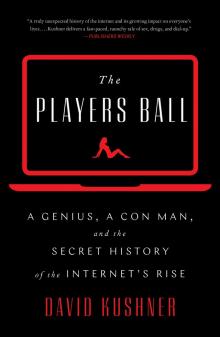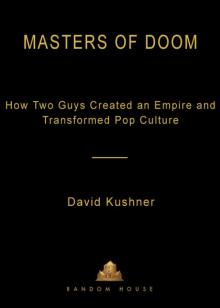- Home
- David Kushner
The Players Ball Page 2
The Players Ball Read online
Page 2
The infraction didn’t help him at home, where he was increasingly butting heads with his domineering mother. No matter what he did, he felt, it was never good enough for her. His room wasn’t clean enough, his grades weren’t high enough, and, as she reminded him again and again, he wasn’t keeping pace with the other bright Jewish boys in the highly competitive town. And there was no one she reminded him about more than a kid named Sheldon—the mere mention of his name made Kremen’s stomach churn.
If Kremen scored a 95 on a test, his mother would tell him Sheldon had scored 97. Kremen went around in stained T-shirts and faded jeans; Sheldon wore button-up shirts and slacks. Sheldon had even won the Golden Apple award, the highest honor a teacher could bestow on a student. And yet as much as Kremen resented Sheldon’s success, he wanted to be him. And since there was no way, in the eyes of his mother, he could ever live up to the glory of Sheldon, Kremen acted out.
Kremen egged Sheldon’s house. He sent him porn subscriptions. And, late one night, he snuck onto Sheldon’s lawn with a can of Glade air freshener. No one saw him in the shadows as he furtively sprayed the lawn in a design of his intent. At first, his handiwork would be imperceptible. But, in the days to come, it would magically appear. And then one delectable morning, Sheldon traipsed outside with his perfectly parted hair and starched shirt to find a message waiting for him in the lawn where the Glade had achieved its toxic effect, killing the grass with which it had come into contact and leaving his message etched in the lawn.
“Fuck you, Sheldon,” it read.
* * *
Early adopters like Kremen had to work hard to get access to computers in the early 1980s. Personal computers were still new and expensive. Apple had introduced the first one in 1977, and IBM’s first PCs, which came in 1981, cost at least $1,500, more than most could afford. The only way for Kremen to get his fingers on a machine was at college.
While pursuing two degrees—one in electrical engineering and the other in computer science—at Northwestern, he got a job in the school administration’s computer room, which was filled with the large mainframe machines of the time. Kremen had to wait for the other nerds to get off the terminals to give him a chance. Once on, Kremen was happy to feed the paper punch cards—which contained the computer code—into the machines, amazed by how the programs came to life.
Light-years ahead of the other students, he’d get bored and distracted in class, putting off his assignments until way after the due date—then backdating them on the computer to make it look as if he had turned them in on time. When other students wanted to know their grades, he sold them access—taking money to log on to the systems and give them the information. It wasn’t even about the money so much as the power, as he later put it, “just to show how important I am.” It was nice while it lasted—until a student turned him in, and Kremen got fired.
But the bug was firmly planted in his brain, and Kremen, with his skills and grades, had his pick of places to go after graduating cum laude to get his geek on. These were the Reagan years, and with the defense buildup, demand was high for computer engineers. Kremen took a job with Aerospace Corporation, a defense nonprofit outside Los Angeles, where his job was to evaluate the cost of software for defense projects and early network security. But, really, what appealed to him was something more primal: the opportunity to spend 1985, as he later put it, “playing on the nascent internet.”
For Kremen, the internet felt like the natural evolution of ham radio, except that instead of going down to his father’s basement he could sit at this machine. And it was all still younger than even him. The roots of the internet started in 1969, when the Advanced Research Projects Agency, the part of the United States Department of Defense responsible for technology research, launched the first online network, known as ARPANET. The purpose was to provide an emergency means for government, research, and education communication in the event of a military strike taking down the phones.
A quick succession of innovations transformed the ARPANET into something more robust. Two years later, in 1971, came electronic mail, designed by Ray Tomlinson, a pioneering computer scientist on the ARPANET, who wanted to create a means for people on different computers to send messages to each other. Stanford researchers Vinton Cerf, Yogen Dalal, and Carl Sunshine soon established a methodology for sending information over a network, calling it a “transmission control protocol / internet protocol (TCP/IP) network.” They had also coined the word that would then be used to describe this new world: the internet.
To connect from one computer to another, Kremen had to make a file transfer protocol, or FTP, request, essentially asking another machine to send him back files. With his position, he could make a request to a German military site, which would reply with a screen for him to log on. Even though he couldn’t get in, just the sheer transaction—the knocking on the door of this computer halfway across the world—felt like some weird kind of teleportation made real. It felt as thrilling as connecting with someone around the world on his ham radio. Oh my God! he thought, staring at the blinking lights before him, there’s something out there.
Much of the community, what there was at the time, congregated on Usenet, a free system of discussion boards that had launched in 1980. Kremen surfed through the fifty or sixty Usenet boards, also known as newsgroups, that were up and running, reading them over a long day at his desk: discussions devoted to Star Trek, computer games, and sex. It wasn’t just discussions, he saw, there were people selling things to each other: albums, clothes, posters. For the hell of it, he bought himself a gun from someone online, just to see if he could. It gave a glimpse, he figured, of a future when people could buy all kinds of things online.
Kremen’s mind had a way of racing ahead; perhaps it was undiagnosed attention deficit disorder, but it felt like he couldn’t keep internally still. There was so much to do, to create, to innovate, and now, with all this online, it felt staggering. One week during a break, he decided he needed some physical and mental space, and drove off into the desert outside L.A. alone. For five days, he fasted, only drinking water, and reading science fiction novels under the endless blue sky.
The future, he sensed, was exploding around him. This internet, this new frontier, like the endless rippling ribbons of heat rolling over the red desert floor, unfolding. This was still so larval, so new, so lonely in a way, like a tiny new bar in back of a small town. But Kremen saw something in it, a future of community and commerce, a world where people could socialize and shop. There were times in his life when he had little epiphanies, and this was one of them: “money is going to be made from this.” He wanted one of those people making money to be him. This meant leaving his job to make this dream a reality. And he knew the best place to make that dream come true: Silicon Valley.
* * *
In the fall of 1987, there was one newcomer wandering across the Stanford University campus who was especially eager to stake his claim: Kremen, who was there to begin his master’s in business administration. Twenty-five years old, dressed in jeans and a T-shirt, he soaked up the thrill of being there, the smell of the eucalyptus trees and the sight of the immaculate sandstone buildings with red-tile rooftops.
Getting accepted to such a prestigious school, he knew, wouldn’t be easy. Stanford’s MBA program was among the smallest and most competitive—with only about three hundred students, half that of Harvard or Wharton. So he had taken what he thought was a counterintuitive approach to his application. “People’s natural instinct is to tell people how great they are,” as he later put it, “but the most successful people understand what someone’s problems are and try to solve them, and make a contribution.” The problem Stanford had, he surmised, was finding students who weren’t going to embarrass the school. So he played up how his unique combination of engineering skills, nonprofit experience, and business savvy would enable him to make the greatest contributions of all. The plan worked, he was accepted.
But as he wandered into the mix
er for new MBA students, he couldn’t help but feel like a fish out of water again. Despite his best efforts, he was still underdressed. Everyone seemed to be in a suit but him. He wasn’t just the worst dressed person there, he noticed, he was the youngest and most socially awkward. As he looked around the room at the people with their shiny suits, firm handshakes, and toothy grins, schmoozing so deftly under the Intel and IBM signs on the wall, he felt his stomach sink as if he was back in Lincolnwood in a room full of Sheldons. What a bunch of assholes, he thought, as he headed for the snacks.
It wasn’t just the students who rubbed him the wrong way, it was the professors. They seemed stuck in the corporate mind-set, rather than the kind of entrepreneurial spirit he admired. Most didn’t have external email accounts, or, to Kremen’s astonishment, even know what the internet was at all. Kremen felt like he was from some other generation that just hadn’t taken hold yet. Fortunately for him, however, there were like-minded eccentrics among the MBA program. Together, they explored the Bay Area, taking in Dead shows, dropping acid, hanging out at dive bars in Palo Alto and San Francisco.
Even among the oddballs, Kremen was particularly “playful and kooky,” as his friend Simon Glinsky put it. He had a voracious, and offbeat, curiosity—questioning possibilities and opportunities at a frenetic pace. At a Giants game, he turned to his college buddy, Phil Van Munching, and asked him if a fly ball that fell into an earthquake fissure on the field would be a ground rule double. Whenever Van Munching owed Kremen money, Kremen would write something embarrassing on the back of the check—like “I don’t wear underwear”—so that Munching would have to sign his name above it in order to get the cash.
Glinsky and Kremen joined the Stanford Follies, a musical theater group on campus. Kremen had an idea for a production. There was a metal abstract sculpture in the middle of campus of a group of birds, though to Kremen it looked more like bird shit. The Bird had become a meeting spot, and one day, under Kremen’s direction, the Follies showed up dressed like giant birds and camped it up absurdly around the mystified students. He was charmingly uncouth, chastising a friend for taking so long cutting the fat from a steak. “You’re being ridiculous,” Kremen said, jabbing the fat with a fork and eating it himself.
For competitive brainiacs in the 1980s, there was one place to go to live the dream: Wall Street, which is just where Gary Kremen found himself in the summer of 1988, after his first year at Stanford. Kremen’s high marks had gotten him recruited for an internship at the most renowned Wall Street firm of all, Goldman Sachs, in New York City.
But Kremen, as always, was an outsider from the moment he showed up at 85 Broad Street downtown. He had to ask someone on the subway to show him how to knot his tie. For a guy who’d only dressed up for bar mitzvahs or funerals, reporting for duty in a suit felt like being straitjacketed. The macho fraternity of Reaganites didn’t help. Kremen bristled being the lowest pledge on the rung, ordered to pick up someone’s laundry or go to an apartment to feed someone’s cat. Unwilling to play the game, he’d mumble under his breath—“Oh this is another idiot”—and start showing up increasingly disheveled, hip-hop cranked on his Walkman headphones. After a few weeks, the boss finally pulled him off the trading floor and offered to buy out the rest of Kremen’s summer internship, if he’d just go away.
Happy to ditch the job and his suit, Kremen returned prematurely to Palo Alto with what he later called a “capitalist migraine,” and an even greater conviction to pursue his true passion: computers. For Kremen, being part of the dawning internet subculture of Silicon Valley had a similarly rebellious feel. The frontier was so new that there was barely anyone really there. The real learning was to be done off campus, so Kremen took consulting jobs writing business plans for start-ups around town, figuring out how to help others raise cash. Burdened with more than $50,000 in loans, he was struggling to get by, and needed whatever income he could muster.
Just after graduation, he founded a business of his own. Kremen was sharing a house in the hills of nearby Los Altos with Ben Dubin, a young engineer who worked for Sun Microsystems, the pioneering computer maker. It was a scrappy house, with a pool and hot tub in the back, and a lock that never had a key. They’d spend their nights getting high in the bubbling water, plotting the businesses they could start. When Dubin told Kremen that Sun was auctioning off old UNIX computers, the two camped out all night until the first sales were available the next morning, and bought several on their credit cards, for $600 each. Dubin then got to work, refurbishing the computers so they could flip them for $2,500 apiece. They advertised the computers in the back of computer hobbyist magazines, and on newsgroups. It was one of the earliest examples of what would later be called e-commerce, except this was as informal as it could get—just a kind of glorified classified ad, using the computer as the medium instead of a newspaper.
But there were enough early adopters to make Kremen’s strategy effective, so he got an idea for expansion. People were sharing their own software on Usenet—say, checkbook balancing programs, games, calculators—like a swap meet. Again, Kremen’s approach to business was to solve people’s problems, and he saw one in all this. People off the internet had a problem because they didn’t know how to get the software that was being distributed online. Why don’t I take some of the software on Usenet, put in on tapes, and sell it to people who don’t have internet access? Kremen thought.
Kremen and Dubin called their company Full Source Software. They began downloading the programs online, then bundling them onto an old computer tape, and selling them through ads in computer magazines—forty programs on one tape for $99. The people who wrote the programs weren’t getting any of the cash, but this was an unregulated world, and Kremen had rationalized that they were already giving their stuff away for free.
Sure enough, his hunch was right—and he began selling bundle after bundle of UNIX programs by mail. Before long, he and Dubin were making a couple grand a month each, nothing wild, but enough for them to live on. Customers began writing and requesting specific programs to be included, and Kremen expanded their slate to meet their needs and cover their student loans. They started writing their own antivirus programs to include in the bundles, and, as an added incentive, games. The games became so popular that people were ordering the bundles for their companies just so they could get the games for themselves. Finally it hit him: his customers were just a bunch of geeky guys like himself. Geeky guys like games, and he knew there was one other thing they wanted as well: naked pictures, just like the boys of Lincolnwood wanted Playboys.
Here was the thing that Kremen understood. If someone really wanted to see naked pictures, all he had to do was buy a porn magazine at the local convenience store. But that required two things: money and, for most guys, some degree of shame. Few people wanted to have to ask some clerk to hand him a copy of Juggs from behind the counter. That was a problem waiting to be solved. People wanted to consume sexual content as discreetly as possible. And, in the late 1980s, there was no more discreet way to do this than online.
From the early days of the internet, people were trying in vain to see naked pictures online. Problem was, the bandwidth posed a challenge for viewing images. Image files were simply too big to be uploaded and downloaded given the limited access most early adopters had to the net. At first, people didn’t bother with images at all. Instead, they created so-called ASCII art. ASCII stood for American Standard Code for Information Interchange, and basically meant the standard typographic characters on the keyboard: letters, numbers, commas, and so on. When deftly combined the rows of characters could form images—almost like pointillism but with typography instead. It was, in effect, a subcultural predecessor of the emoticons that would later proliferate online.
While ASCII porn still proliferated, surfers had moved on more recently to sharing pages scanned (at a copy shop, since there were few scanners in the homes) from porn magazines—even though it required tremendous patience and effort. Since it would tak
e too long to upload and download a photo image, people distributed the pictures as raw data, or binary files, that could be reassembled using special programs. In practice, compressing the binaries felt like playing some kind of privately dirty puzzle game—and the sheer novelty of getting dirty pictures over a computer provided motivation enough.
Someone would sit at his computer, surf over to a newsgroup such as alt.binaries.pictures.erotica, then see a heading for, say, the latest Playboy centerfold. There would then be a series of links to differing binary files, which had to be downloaded one by one, then put back together through software such as UnStuffit. It took several minutes, in all, but the reward felt tantalizing, as the finished image slowly materialized, one row of pixels at a time, until it filled the screen in all its fleshy deliciousness. Or, for people who didn’t have the will or skills to do all that, there was Kremen—who, accurately, figured that throwing some naked photos on his compilation tapes would be just the Cracker Jack prize to entice people around the country to order his wares.
That wasn’t all customers wanted. They wanted computer security programs. So Kremen started another company, Los Altos Technologies, with Dubin as chief technical officer, devoted to making such wares. Renting an office in a crappy building in Palo Alto, Kremen raised money from an investor to hire a CEO. The CEO had religious beliefs and wasn’t thrilled to find out about the porn included on the discs. “We’re having a meeting,” he told Kremen, “and we’re gonna talk about what nobody wants to talk about—this behavior goes against Jesus.” But Kremen took it in stride. Having a short attention span created challenges in his personal life, but manifested in his professional life as it did for many like him, as a serial entrepreneur. The thrill, for Kremen, was the inception and creation, coming up with an idea, writing the business plan, bringing it to life, cashing in, then moving on to the next enterprise. And he already had another one in mind.

 The Players Ball
The Players Ball Alligator Candy
Alligator Candy Levittown
Levittown Jacked: The Outlaw Story of Grand Theft Auto
Jacked: The Outlaw Story of Grand Theft Auto Masters of Doom
Masters of Doom